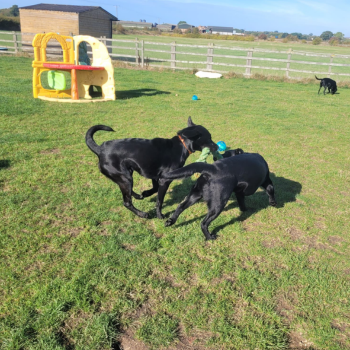![]()
Spotting the signs of when your dog is in pain
Doggy Day Care at the Willows
![]()
 When your canine companion isn’t well, it can be distressing for your pet and your family. Learning how to spot the signs of when your dog is in pain will enable you to reduce their suffering and support their health and wellbeing. There are various illnesses and conditions that can affect a dog, including painful musculoskeletal issues that can often go unnoticed.
When your canine companion isn’t well, it can be distressing for your pet and your family. Learning how to spot the signs of when your dog is in pain will enable you to reduce their suffering and support their health and wellbeing. There are various illnesses and conditions that can affect a dog, including painful musculoskeletal issues that can often go unnoticed.
What are the signs that your dog is unwell?
Nobody knows your dog better than you, so consider their usual behaviour and whether they appear to be acting out of character.
Below are several signs of when a dog is in pain:
- Mobility issues such as a change in posture, limp or hopping, as well as difficulty lying down or getting up.
- Lack of interest or refusal to walk or walking slower than usual.
- Irritability, whimpering or growling, howling or seeming listless.
- Lethargy such as a lack of energy or sleeping excessively.
- Indoor toileting if toilet-trained or struggling when toileting.
- Reluctance to be touched or handled.
- Excessive licking of certain body areas.
- Difficulty eating or not eating at all.
What should I do if my dog is in pain?
Make them as comfortable as possible and contact your vet. Depending on the severity of the symptoms, it’s important to act quickly and seek advice as soon as possible. They may have an injury or illness that needs treating urgently, and your vet can advise on painkillers.
Whether your dog is diagnosed with an acute or chronic condition, try to manage their pain in relation to their symptoms. As an example, you could move food and water bowls closer to their bed. You could make their bed more comfortable with soft cushions. If your dog has a mobility issue, you can buy ramps to help them get into the car. Also, make sure any slippery surfaces in your home are covered by a secure mat to prevent them from slipping over.
Hip dysplasia in dogs
Hip dysplasia is a painful condition that’s usually inherited from a parent and can result in swelling and arthritis as the dog gets older. It causes one or both hip joints to develop abnormally while a puppy is growing. However, it can also be affected by environmental factors. Diet, exercise and a puppy’s weight while growing can contribute to this condition.
Poor nutrition during puppyhood can have a negative impact on bone and joint development. Overfeeding a puppy with the wrong or high-calorie foods can lead to rapid weight gain, which puts excessive pressure on developing joints. This can exacerbate hip dysplasia. Too much or inappropriate exercise, such as repetitive jumping, or strenuous activities can also worsen this condition.
Certain breeds are more susceptible to genetic conditions such as canine hip dysplasia, and this is something we often see at our doggy daycare centres. The most common breeds affected are medium to large pedigree dogs.
When it comes to treating hip dysplasia, this is usually through careful weight control and exercise, and sometimes pain relief. If your dog is severely affected, then surgery might be needed. It’s important to check for hip dysplasia if you are considering dog breeding to reduce the number of puppies being born with this painful condition.
Monitoring your dog’s health
We’ve written a few guides on managing your dog’s health and wellbeing – see below or visit our News page:
- What causes digestive issues in dogs?
- How to deal with fleas on dogs and in the home
- What are the signs of heatstroke and parasites in dogs?
- How to make vet visits less stressful and calmer for your dog
Your caring doggy day care centre
At Doggy Daycare at the Willows, we have a team of fully trained Doggy Daycare Assistants who are dedicated to managing your dog’s wellbeing. Please let us know immediately if you believe your dog is suffering from any type of condition. If the issue is contagious, we’ll need to protect the health of our other canine guests. Speak to your vet if you have any concerns.
Learn more about our doggy day care services by getting in touch for a chat with our team.
Thank you for reading our latest blog, Spotting the signs of when your dog is in pain.
Sources:
https://www.petmd.com/dog/general-health/how-to-tell-if-your-dog-is-in-pain
https://www.bluecross.org.uk/advice/dog/health-and-injuries/how-to-spot-if-your-dog-is-in-pain
https://www.pdsa.org.uk/pet-help-and-advice/pet-health-hub/conditions/hip-dysplasia-in-dogs
